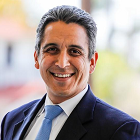Ricardo Flores, director of LISC San Diego, kicks off our recognition of Hispanic Heritage Month with a blog about how working in partnership with Latino communities is key to the health of the country, and part of the fundamental relationship between local and national prosperity. "The conditions of the Latino population today provide us with a peek into the wellbeing of our society tomorrow and in the years to come," writes Flores.
Photo courtesy City Heights Community Development Corporation.
Each year since 1968, our nation has recognized the contributions of Hispanic and Latino Americans to the United States and has celebrated their cultural heritage and history.
To be sure, this year’s anniversary comes at a time of rising uncertainty for many within the Latino community, as immigration policy hangs in the balance. But one thing is certain: Latinos, who have played formative roles in the history of this land since the 16th century, are an ever-growing force in the social, economic and political life of the United States.
According to demographers, by 2050 my hometown of San Diego will be 41 percent Latino, the state of California will be 47 percent Latino, and the U.S. as a whole will be 29 percent Latino.
These population shifts offer an enormous opportunity to harness the energy and potential in our Latino communities, so that all residents can contribute to the health of their neighborhoods and to the country as a whole. And if demography is truly destiny, the conditions of the Latino population today provide us with a peek into the wellbeing of our population tomorrow and in the years to come.
As a Latino American who spent his formative years in San Diego’s City Heights neighborhood, a historically underinvested area that has suffered from high crime rates, I consider myself a prime example of the kind of upward mobility that can, with good fortune, be achieved through education, persistence and sweat equity. My parents were activists in the Chicano movement of the 1960s who would later graduate from San Diego State University and enjoy successful careers as elementary school principals. I know they’re proud that I earned a degree from UCLA.
Yet for all the irrefutable examples of generational advances like my family’s, statistics tell us that far too many Latinos still live in poverty (some 24 percent nationally; nearly 30 percent in California) and too few attain a high school or college-level degree. This is a population with the same potential and talent as I had, but in many cases without the scaffolding and access to realize that potential.
Today, as executive director of LISC San Diego, I work in the very neighborhood where I am from, City Heights, whose Latino, immigrant and refugee residents have struggled to share in the extraordinary assets and prosperity of the state.
Our mission at LISC is to bridge the gap between communities, to help connect low-income people with the opportunity that should be theirs to grasp. In City Heights, we’ve done that by working with our local partners to finance the Fair@44, an open-air, international food market and much-needed public gathering space that also serves as an incubator for new businesses. And our Financial Opportunity Center at the nearby International Rescue Committee office offers employment and career services, financial education and coaching, and low-cost financial products that encourage investment and savings to City Heights families.
Across the city, we provide low-interest loans to build affordable housing, revitalize economic corridors to create jobs, and provide technical assistance to small, community-based nonprofits, many of which serve a largely Latino clientele.
This is the work LISC does all across the country, in neighborhoods where people who trace their roots to Mexico and Central and South America have made a home. From the Latin American Youth Center in Washington D.C. to the Southside Culture Center in Providence, RI, to Raza Development Fund in Phoenix, we partner with a broad range of organizations that share our commitment to nurturing thriving Latino communities.
And this is the work we’ve been doing in San Diego for more than 25 years. In that time we have invested over $230 million to build 6,300 affordable apartments and homes along with 1 million feet of commercial space. We have provided $3 million in grants to community based non-profits and helped over 1,300 individuals get a footing in financial stability and find new careers through our Financial Opportunity Centers.
Celebrating National Hispanic Heritage Month is a mark of our dedication to all of our communities. And if past is prologue, as we continue to confront today’s challenges, I’m certain my fellow Latinos will very much be part of the solution.
 ABOUT THE AUTHOR
ABOUT THE AUTHOR
Ricardo Flores, Executive Director, LISC San Diego
Ricardo Flores became executive director of LISC San Diego in Spring 2017. Prior to that, he served as chief of staff for San Diego’s city council president, and was a senior aide to U.S. congresswoman Susan Davis. A native of City Heights, Ricardo graduated from UCLA and today, he and his wife live in the Kensington neighborhood with their rescue lab.